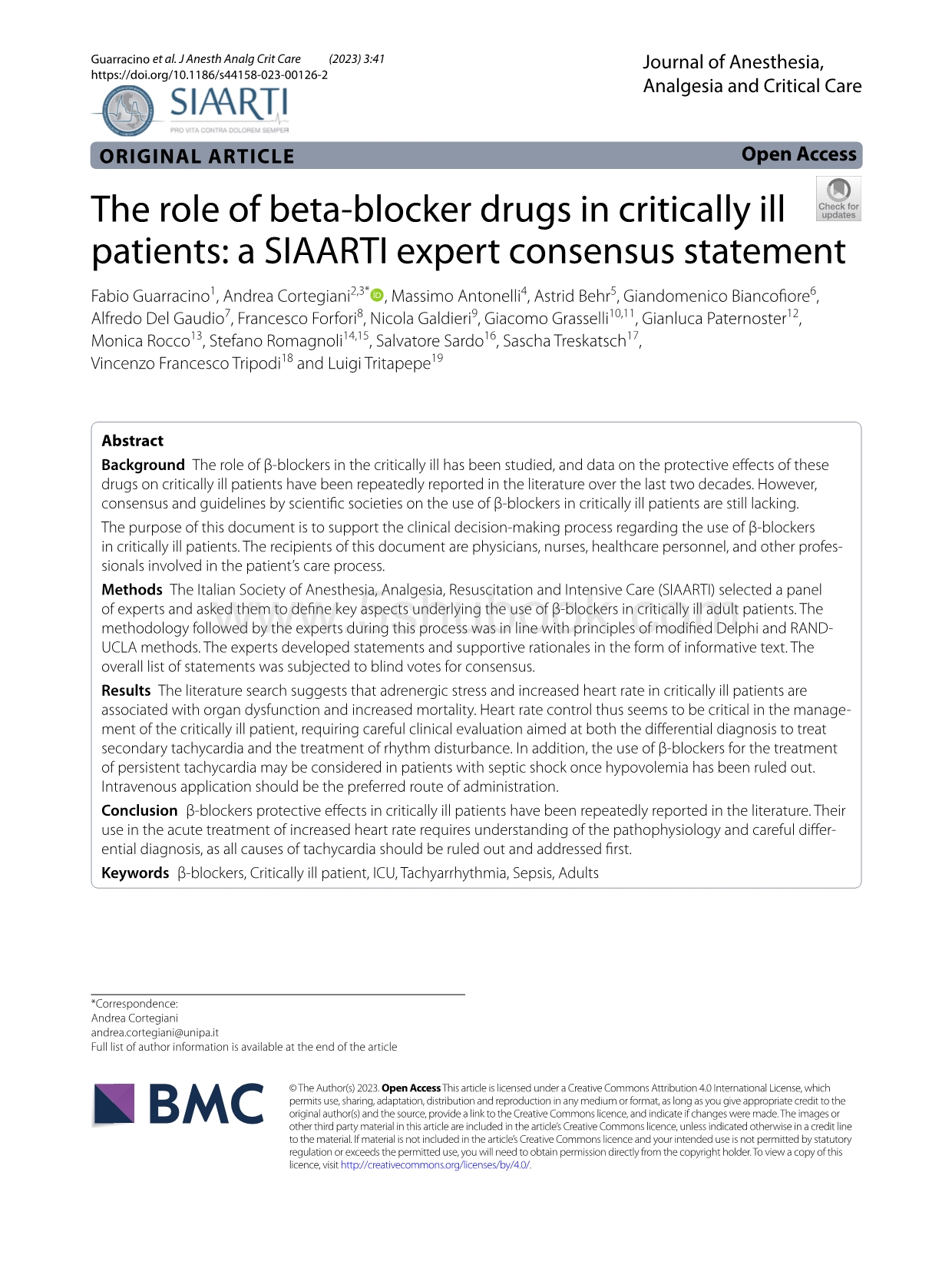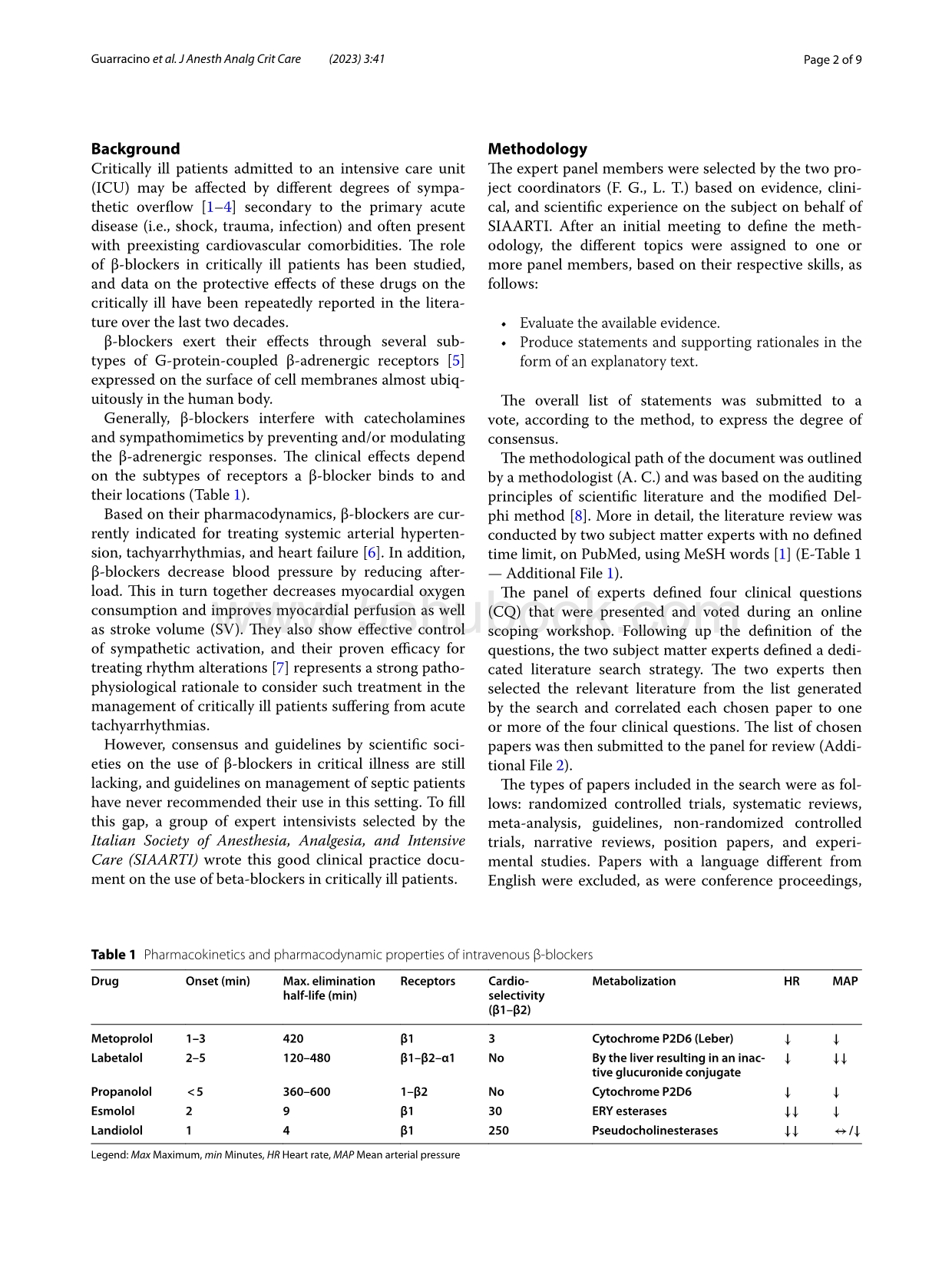
 2023+SIAARTI专家共识声明:β受体阻滞剂在重症患者中的作用(英文版).pdf
2023+SIAARTI专家共识声明:β受体阻滞剂在重症患者中的作用(英文版).pdf
《2023+SIAARTI专家共识声明:β受体阻滞剂在重症患者中的作用(英文版).pdf》由会员分享,可在线阅读,更多相关《2023+SIAARTI专家共识声明:β受体阻滞剂在重症患者中的作用(英文版).pdf(9页珍藏版)》请在周易易学书店|道易五术书社上搜索。
1、Guarracinoetal.J Anesth Analg Crit Care https:/doi.org/10.1186/s44158-023-00126-2ORIGINAL ARTICLEOpen Access The Author(s)2023.Open Access This article is licensed under a Creative Commons Attribution 4.0 International License,which permits use,sharing,adaptation,distribution and reproduction in any
2、 medium or format,as long as you give appropriate credit to the original author(s)and the source,provide a link to the Creative Commons licence,and indicate if changes were made.The images or other third party material in this article are included in the articles Creative Commons licence,unless indi
3、cated otherwise in a credit line to the material.If material is not included in the articles Creative Commons licence and your intended use is not permitted by statutory regulation or exceeds the permitted use,you will need to obtain permission directly from the copyright holder.To view a copy of th
4、is licence,visit http:/creativecommons.org/licenses/by/4.0/.Journal of Anesthesia,Analgesia and Critical CareThe role ofbeta-blocker drugs incritically ill patients:aSIAARTI expert consensus statementFabio Guarracino1,Andrea Cortegiani2,3*,Massimo Antonelli4,Astrid Behr5,Giandomenico Biancoore6,Alfr
5、edo Del Gaudio7,Francesco Forfori8,Nicola Galdieri9,Giacomo Grasselli10,11,Gianluca Paternoster12,Monica Rocco13,Stefano Romagnoli14,15,Salvatore Sardo16,Sascha Treskatsch17,Vincenzo Francesco Tripodi18 and Luigi Tritapepe19 Abstract Background The role of-blockers in the critically ill has been stu
6、died,and data on the protective eects of these drugs on critically ill patients have been repeatedly reported in the literature over the last two decades.However,consensus and guidelines by scientic societies on the use of-blockers in critically ill patients are still lacking.The purpose of this doc
7、ument is to support the clinical decision-making process regarding the use of-blockers in critically ill patients.The recipients of this document are physicians,nurses,healthcare personnel,and other profes-sionals involved in the patients care process.Methods The Italian Society of Anesthesia,Analge
8、sia,Resuscitation and Intensive Care(SIAARTI)selected a panel of experts and asked them to dene key aspects underlying the use of-blockers in critically ill adult patients.The methodology followed by the experts during this process was in line with principles of modied Delphi and RAND-UCLA methods.T
9、he experts developed statements and supportive rationales in the form of informative text.The overall list of statements was subjected to blind votes for consensus.Results The literature search suggests that adrenergic stress and increased heart rate in critically ill patients are associated with or
10、gan dysfunction and increased mortality.Heart rate control thus seems to be critical in the manage-ment of the critically ill patient,requiring careful clinical evaluation aimed at both the dierential diagnosis to treat secondary tachycardia and the treatment of rhythm disturbance.In addition,the us
11、e of-blockers for the treatment of persistent tachycardia may be considered in patients with septic shock once hypovolemia has been ruled out.Intravenous application should be the preferred route of administration.Conclusion-blockers protective eects in critically ill patients have been repeatedly r
12、eported in the literature.Their use in the acute treatment of increased heart rate requires understanding of the pathophysiology and careful dier-ential diagnosis,as all causes of tachycardia should be ruled out and addressed rst.Keywords-blockers,Critically ill patient,ICU,Tachyarrhythmia,Sepsis,Ad
13、ults*Correspondence:Andrea Cortegianiandrea.cortegianiunipa.itFull list of author information is available at the end of the articlePage 2 of 9 Guarracinoetal.J Anesth Analg Crit Care BackgroundCritically ill patients admitted to an intensive care unit(ICU)may be aected by dierent degrees of sympa-t
14、hetic overow 14 secondary to the primary acute disease(i.e.,shock,trauma,infection)and often present with preexisting cardiovascular comorbidities.e role of-blockers in critically ill patients has been studied,and data on the protective eects of these drugs on the critically ill have been repeatedly
15、 reported in the litera-ture over the last two decades.-blockers exert their eects through several sub-types of G-protein-coupled-adrenergic receptors 5 expressed on the surface of cell membranes almost ubiq-uitously in the human body.Generally,-blockers interfere with catecholamines and sympathomim
16、etics by preventing and/or modulating the-adrenergic responses.e clinical eects depend on the subtypes of receptors a-blocker binds to and their locations(Table1).Based on their pharmacodynamics,-blockers are cur-rently indicated for treating systemic arterial hyperten-sion,tachyarrhythmias,and hear
17、t failure 6.In addition,-blockers decrease blood pressure by reducing after-load.is in turn together decreases myocardial oxygen consumption and improves myocardial perfusion as well as stroke volume(SV).ey also show eective control of sympathetic activation,and their proven ecacy for treating rhyth
18、m alterations 7 represents a strong patho-physiological rationale to consider such treatment in the management of critically ill patients suering from acute tachyarrhythmias.However,consensus and guidelines by scientic soci-eties on the use of-blockers in critical illness are still lacking,and guide
19、lines on management of septic patients have never recommended their use in this setting.To ll this gap,a group of expert intensivists selected by the Italian Society of Anesthesia,Analgesia,and Intensive Care(SIAARTI)wrote this good clinical practice docu-ment on the use of beta-blockers in critical
20、ly ill patients.Methodologye expert panel members were selected by the two pro-ject coordinators(F.G.,L.T.)based on evidence,clini-cal,and scientic experience on the subject on behalf of SIAARTI.After an initial meeting to dene the meth-odology,the dierent topics were assigned to one or more panel m
21、embers,based on their respective skills,as follows:Evaluate the available evidence.Produce statements and supporting rationales in the form of an explanatory text.e overall list of statements was submitted to a vote,according to the method,to express the degree of consensus.e methodological path of
22、the document was outlined by a methodologist(A.C.)and was based on the auditing principles of scientic literature and the modied Del-phi method 8.More in detail,the literature review was conducted by two subject matter experts with no dened time limit,on PubMed,using MeSH words 1(E-Table1 Additional
23、 File 1).e panel of experts dened four clinical questions(CQ)that were presented and voted during an online scoping workshop.Following up the denition of the questions,the two subject matter experts dened a dedi-cated literature search strategy.e two experts then selected the relevant literature fro
24、m the list generated by the search and correlated each chosen paper to one or more of the four clinical questions.e list of chosen papers was then submitted to the panel for review(Addi-tional File 2).e types of papers included in the search were as fol-lows:randomized controlled trials,systematic r
25、eviews,meta-analysis,guidelines,non-randomized controlled trials,narrative reviews,position papers,and experi-mental studies.Papers with a language dierent from English were excluded,as were conference proceedings,Table 1 Pharmacokinetics and pharmacodynamic properties of intravenous-blockersLegend:



- 配套讲稿:
如PPT文件的首页显示word图标,表示该PPT已包含配套word讲稿。双击word图标可打开word文档。
- 特殊限制:
部分文档作品中含有的国旗、国徽等图片,仅作为作品整体效果示例展示,禁止商用。设计者仅对作品中独创性部分享有著作权。
- 关 键 词:
- siaarti 专家 共识 共鸣 声明 受体 阻滞剂 重症 患者 中的 作用
 周易易学书店|道易五术书社所有资源均是用户自行上传分享,仅供网友学习交流,未经上传用户书面授权,请勿作他用。
周易易学书店|道易五术书社所有资源均是用户自行上传分享,仅供网友学习交流,未经上传用户书面授权,请勿作他用。









 《风湿病中医特色治疗》·吴启富.pdf(342页)
《风湿病中医特色治疗》·吴启富.pdf(342页)
 【2016爱爱医中医擂台赛】:协定处方院内验方 院内制剂汇集(骨伤科类)天津市中医院.doc(2页)
【2016爱爱医中医擂台赛】:协定处方院内验方 院内制剂汇集(骨伤科类)天津市中医院.doc(2页)
 穴位贴敷疗法(中医特色治疗).ppt(14页)
穴位贴敷疗法(中医特色治疗).ppt(14页)
